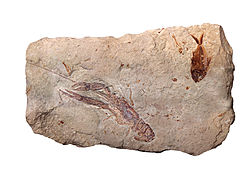|
The Palaeontology Portal
Introduction Paleontology (/ˌpeɪliɒnˈtɒlədʒi, ˌpæli-, -ən-/ PAY-lee-on-TOL-ə-jee, PAL-ee-, -ən-), also spelled palaeontology or palæontology, is the scientific study of life that existed prior to the start of the Holocene epoch (roughly 11,700 years before present). It includes the study of fossils to classify organisms and study their interactions with each other and their environments (their paleoecology). Paleontological observations have been documented as far back as the 5th century BC. The science became established in the 18th century as a result of Georges Cuvier's work on comparative anatomy, and developed rapidly in the 19th century. The term has been used since 1822 formed from Greek παλαιός ('palaios', "old, ancient"), ὄν ('on', (gen. 'ontos'), "being, creature"), and λόγος ('logos', "speech, thought, study"). Paleontology lies on the border between biology and geology, but it differs from archaeology in that it excludes the study of anatomically modern humans. It now uses techniques drawn from a wide range of sciences, including biochemistry, mathematics, and engineering. Use of all these techniques has enabled paleontologists to discover much of the evolutionary history of life, almost back to when Earth became capable of supporting life, nearly 4 billion years ago. As knowledge has increased, paleontology has developed specialised sub-divisions, some of which focus on different types of fossil organisms while others study ecology and environmental history, such as ancient climates. (Full article...) Selected article on the prehistoric world and its legacies
Nigersaurus (meaning "Niger reptile") is a genus of rebbachisaurid sauropod dinosaur that lived during the middle Cretaceous period, about 115 to 105 million years ago. It was discovered in the Elrhaz Formation in an area called Gadoufaoua, in the Republic of Niger. Fossils of this dinosaur were first described in 1976, but it was only named in 1999 after further and more complete remains were found and described. The genus contains a single species, Nigersaurus taqueti.
Nigersaurus was 9 m (30 ft) long, which is small for a sauropod, and had a short neck. It weighed around four tonnes, comparable to a modern elephant. Its skeleton was filled with air spaces connected to air sacs, but the limbs were robustly built. Its skull was very specialised for feeding, with a wide muzzle filled with more than 500 teeth. The jaws may have borne a keratinous sheath. Unlike other tetrapods, the tooth-bearing bones of its jaws were rotated transversely relative to the rest of the skull, so that all of its teeth were located far to the front. Nigersaurus was probably a browser, and fed with its head close to the ground. It lived in a riparian habitat, and its diet probably consisted of soft plants, such as ferns, horsetails, and angiosperms. It is one of the most common fossil vertebrates found in the area, and shared its habitat with other dinosaurian megaherbivores, as well as large theropods and crocodylomorphs. (see more...) Did you know?

General images -The following are images from various paleontology-related articles on Wikipedia.
Selected article on paleontology in human science, culture and economicsJurassic Park is a 1993 American science fiction adventure film directed by Steven Spielberg. It is the first installment of the Jurassic Park franchise. It is based on the 1990 novel of the same name by Michael Crichton, with a screenplay written by Crichton and David Koepp. The film centers on the fictional Isla Nublar, an islet located off Central America's Pacific Coast, near Costa Rica Nicaragua border, where a billionaire philanthropist and a small team of genetic scientists have created a wildlife park of cloned dinosaurs. Following an extensive $65 million marketing campaign, which included licensing deals with 100 companies, Jurassic Park grossed over $900 million worldwide in its original theatrical run. It surpassed Spielberg's 1982 film E.T. the Extra-Terrestrial to become the highest-grossing film until Titanic (1997). Jurassic Park was well received by critics, who praised its special effects and Spielberg's direction but criticized the script. The film won more than 20 awards (including 3 Academy Awards), mostly for its visual effects. Jurassic Park is considered by many to be one of the greatest films of the 1990s and in some cases of all time, as well as a landmark in the vector of visual effects regarding its computer-generated imagery and animatronics. Jurassic Park was followed by two sequels, The Lost World: Jurassic Park and Jurassic Park III, both of which were box office successes but received mixed critical responses. A third sequel, Jurassic World, is set for release on June 12, 2015. (see more...) On this day...June 9:
Selected image
CategoriesTopicsGeneral - Paleontology - Fossil - Evolution - Extinction Quality ContentFeatured paleontology articles
- Achelousaurus
- Acrocanthosaurus
- Albertosaurus
- Allosaurus
- Amargasaurus
- Ankylosaurus
- Apatosaurus
- Archaeopteryx
- Baryonyx
- Carnotaurus
- Catopsbaatar
- Ceratosaurus
- Chicxulub Crater
- Compsognathus
- Cretaceous–Tertiary extinction event
- Daspletosaurus
- Deinocheirus
- Deinonychus
- Deinosuchus
- Dilophosaurus
- Dinosaur
- Diplodocus
- Dromaeosauroides
- Edmontosaurus
- Elasmosaurus
- Giganotosaurus
- Gorgosaurus
- Herrerasaurus
- Iguanodon
- Istiodactylus
- Lambeosaurus
- List of dinosaur genera
- Majungasaurus
- Massospondylus
- Megalodon
- Nemegtomaia
- Nigersaurus
- Opisthocoelicaudia
- Paranthodon
- Parasaurolophus
- Plateosaurus
- Psittacosaurus
- Seorsumuscardinus
- Spinosaurus
- Stegosaurus
- Stegoceras
- Styracosaurus
- Tarbosaurus
- Thescelosaurus
- Triceratops
- Tyrannosaurus
- Velociraptor
Things you can doCurrent Paleontology FACs - None yet... WikiProjectsRelated portalsAssociated WikimediaThe following Wikimedia Foundation sister projects provide more on this subject:
Discover Wikipedia using portals |








































